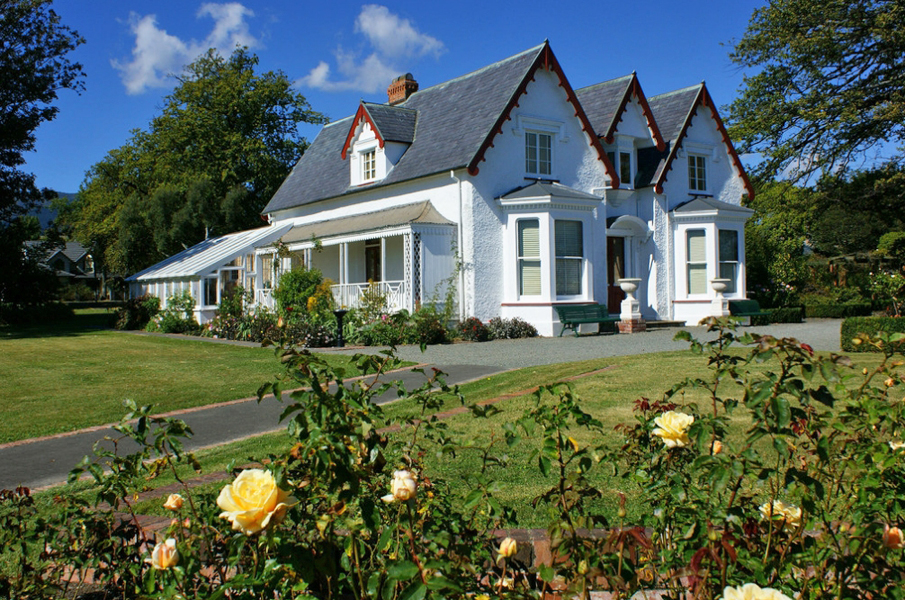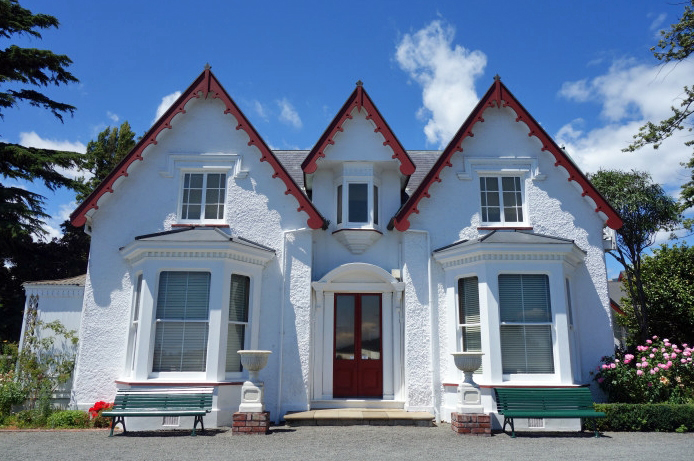Contrasting starkly with the modern houses built on its former estate is Broadgreen Historic House, a two-storey building constructed from cob in the mid 1850s. The house, now operated as a museum, is one of the Nelson region's oldest identified residential buildings. Broadgreen Historic House was constructed for Martha and Edmund Buxton [1805-1882], and their family of six daughters. The exact date Broadgreen was completed is uncertain. In 1854, Buxton purchased the 40 hectares [100 acres] of land on which Broadgreen was erected for £200 from absentee owner W. H. Rawson. By 1857, the high rates charged on the property suggest that a house had been constructed on it by this date. The house is therefore likely to have been erected between 1854 and 1857. Broadgreen Historic House is made of 'cob', or 'clom' as it was called in Lancashire where Buxton was born. Cob houses were a common choice among early New Zealand settlers as they were cheap, easy to construct, and required very few tools. Cob is a wet mixture of clay, dung and straw or horsehair that dries hard, like concrete. The clay used in Broadgreen was excavated from the cellar area underneath the house. The walls of Broadgreen were formed in thick layers that taper slightly towards the top of the building. All the outside corners of the house were rounded off, to prevent the cob from cracking when it dried. As cob is vulnerable to the damp and can collapse if too wet, the house was covered with roughcast plaster on the outside, and smooth plaster on the inside. Further protection from the weather was provided by the overhanging roof, which was made of tiles. Thought to have been modelled on a Devonshire farmhouse, Broadgreen was designed by architect Mr Beatson. With two-storeys and eleven rooms, it is unusually large for a New Zealand cob building and is a symbol of the Buxton family's prosperity. The original layout of the house reflects the Victorian distinction between public and private space that was noticeable in larger residences from that period. When first constructed, the rooms in the upper storey were used as four private bedrooms and a nursery. The dining room and parlour, both areas where visitors were invited to enter, were elaborately decorated and located at the front of the house. Utility rooms such as the kitchen and scullery were tucked away from sight in the rear of the house. The servants who ran the Buxton household may have been accommodated in the attic above the scullery. The Buxton family lived in Broadgreen until Edmund Buxton's death in 1882. The following year the house was purchased by Buxton's third daughter Cordelia, then aged 51 years. Cordelia Buxton remained in the house, living off rents from the estate, until 1901. Seven years later, in 1908, the house was sold to Mary and Fritz [Fred] Langbein. The Langbeins developed the estate grounds but left the house largely unchanged. The property was passed to their son Edward in 1943 and to his son, David, eight years later. David Langbein held the property until 1965 when an agreement was made to sell the house and five acres of land to the Nelson City Council. In 1968, after three years of renovations, the 'Friends of Broadgreen' opened the former Buxton residence as a museum. Stocked with items from the nineteenth-century donated by local residents, the museum is arranged to appear as though the Buxtons were still living in the house. Broadgreen Historic House is of historic and architectural significance as a rare remaining example of a form of house construction once typical of the region, and used throughout New Zealand in the nineteenth-century. The house retains most of its original character and is in excellent condition. Broadgreen is physically significant for the insight it provides into the nature of cob houses and cob construction techniques. The educational value of the house is enhanced by the deliberate effort to highlight this characteristic of the house for museum visitors. Broadgreen is noteworthy for its conversion into a museum and reflects the development of the national trend towards the creation of such museums between 1960 and 1980.The park-like setting of the house, together with the retention of original wallpaper and the inclusion of items that belonged to the residents of the house, adds to the authenticity of the building and enhances its value as a historic resource. The collection of period furniture from local residents adds to the local significance and cultural value of the building. The house is a popular tourist attraction and a valuable educational tool.



Location
List Entry Information
Overview
Detailed List Entry
Status
Listed
List Entry Status
Historic Place Category 1
Access
Able to Visit
List Number
252
Date Entered
4th April 1985
Date of Effect
4th April 1985
City/District Council
Nelson City
Region
Nelson Region
Legal description
Lot 3 DP 7254 RT 3A/178
Stay up to date with Heritage this month
